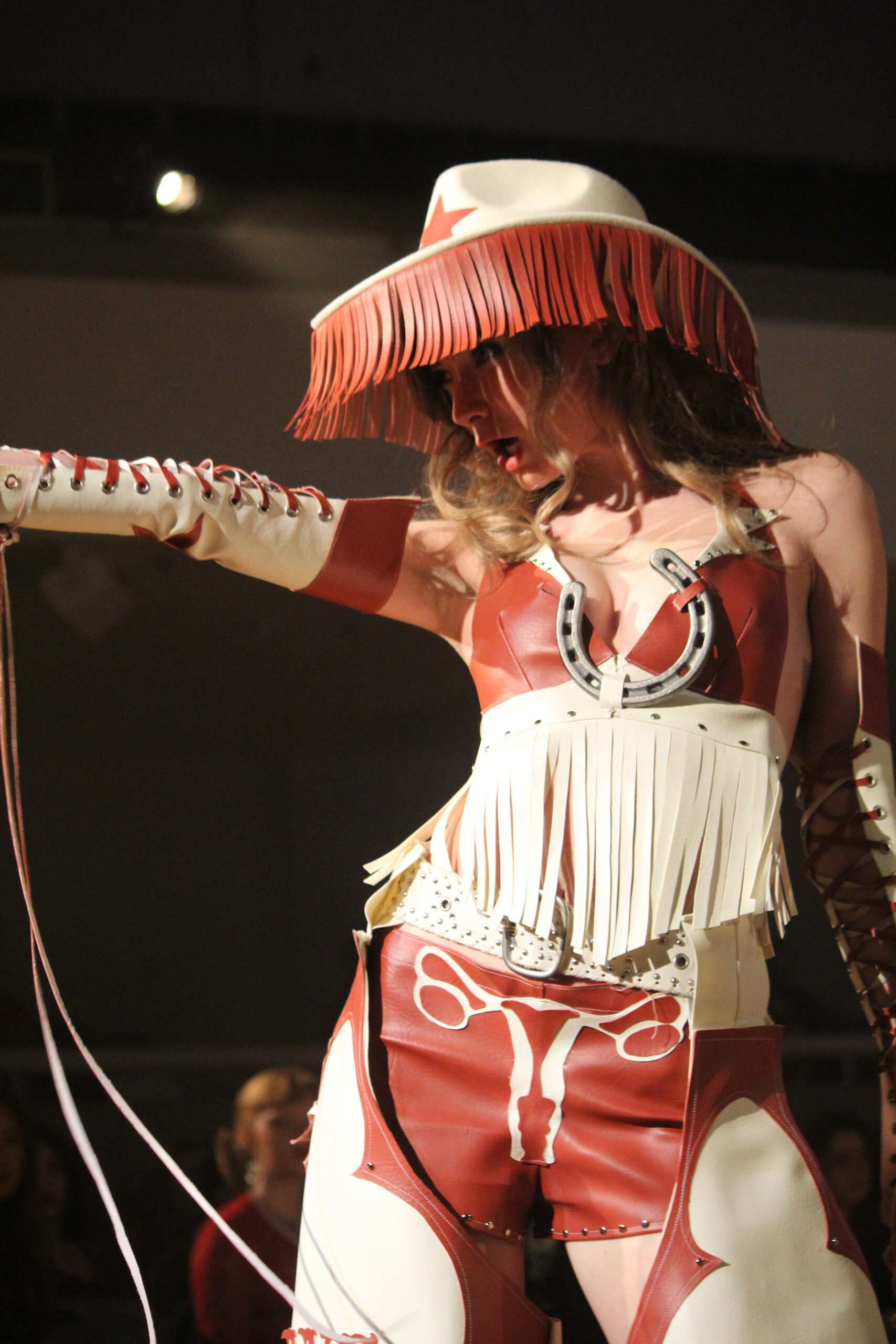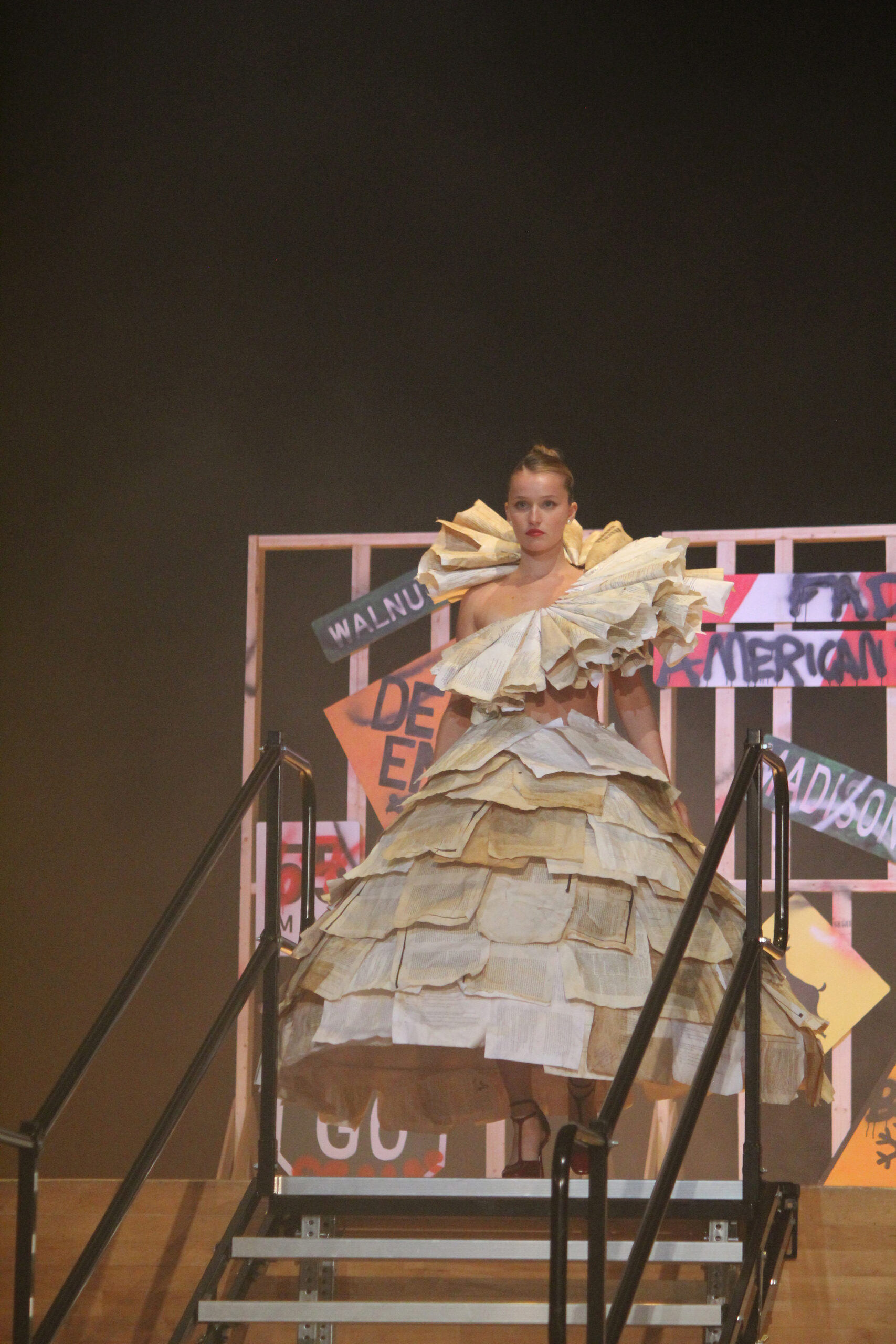FADS disrupts, redefines stereotypical American dream in semester finale

"American Dream: Re:Fashioned" featured the work of 22 student designers. Each collection highlighted individual visions of the American dream. Kaylynn Green | Contributing Photographer
Get the latest Syracuse news delivered right to your inbox.
Subscribe to our newsletter here.
Structures made up of graffiti-covered signs with “USA” and “SU” splattered in red and black ink line the stage. Models, adorned in skirts made of fake money, a Statue of Liberty torch and a bodice covered in the Black American Heritage Flag grace the runway floor, aiming to challenge the status quo of the American dream.
“The theme is all about refashioning, reimagining and critiquing the American dream through a contemporary lens,” said Amaya Evans, co-creative director for Syracuse University’s Fashion and Design Society. “It’s more so just showing the harsher truth (of) what’s not really commonly shown in what the American dream is now today.”
FADS hosted its fall fashion show, “American Dream Re:Fashioned,” at Goldstein Auditorium on Saturday. A total of 55 pieces from 22 designers took the stage, drawing inspiration from the current political climate, students’ culture and a play on traditional American stereotypes.
FADS didn’t want to disregard the current political climate in the United States, Evans said. Designs featured commentary on immigration raids, abortion access, anti-war movements and sustainability, among others.

Sophomore Madeline Wolcott modeled her own design on Saturday. The look was a commentary on restrictions to reproductive freedom in the United States. Kaylynn Green | Contributing Photographer
The show set out to disrupt the traditional American stereotype, elevating the diverse communities and cultures that authentically represent the nation, said Kadiatou Bah, FADS co-model director. FADS President Jada Williams said the show highlighted how the diverse backgrounds, identities and lived experiences across this country form each person’s vision of the American dream, challenging the traditional sense of American aesthetics of the flag and the bald eagle.
At its core, the show explored personal expression, Williams said. Models and designers channeled their critiques and responses through fashion, looking past specific politicians or people and focusing on the issue and message they wanted to convey.
“Our show goes deeper than the average American dream. I feel like everyone who is in America right now, even people who are immigrants, even people who are not from here, they all have their own American dream,” Williams said. “Everybody can interpret their own American dream, and that looks different for every race and every ethnicity.”
The show opened with a lyrical dancer swaying to a piano rendition of “The Star-Spangled Banner.” When another dancer joined her on stage, the audio switched to a narration, detailing an immigrant mother’s sacrifice to grant her son the American dream.
A curated playlist of metal, country and classical music echoed throughout the auditorium, dividing the show into sections through music. Each genre transition signaled a move to the next theme, Evans said.

Senior Mikah Bein’s design closed out the show. Gracie Koslowsky modeled the dress to the song “O Say, Can You See?” by Zeshan B. Kaylynn Green | Contributing Photographer
Checkered textiles, glamorous gowns and flowy linens, soundtracked by Rose Royce’s “Wishing on a Star,” blended into Kendrick Lamar’s “Alright,” with models flaunting their distressed and structured denim pieces. Other songs included “Bullet The Blue Sky” by U2 and “Scars and Stripes Forever” by Genitorturers.
“We have our music that represents that sorrow and that rawness of what the American dream kind of represents,” Williams said. “So we have rock, and mellow country. We have all (the) things that represent the different eras of America and what was portrayed.”
Hoping to broaden the show’s perspective, Creative Directors Claire McConnell and Evans said they pushed the designers to look inward and ask: “What does the American dream mean to you in today’s world?”
In creating the theme, the two said they discovered that each designer had their own take — either personal or cultural — on the theme, helping the show flourish in its process.
“For me, the American Dream Re:Fashioned is just as much a counter-cultural theme as it is recognizing and uplifting some of the patriotic values that this country holds,” McConnell said. “For me, the biggest thing is, I aim to critique those things in my looks specifically.”
Madeline Wolcott, a sophomore fashion design major, modeled and designed her own Western cowboy look. The outfit featured chaps with “Hands Off Our Bodies” and “We Are Not Livestock” emblazoned on each leg.
Wolcott said she was inspired by the way women are impacted by legislation that restricts reproductive freedom.
“With my look, I am trying to emphasize women having complete and full bodily autonomy in order to live a completely free and independent life — like the archetype of the cowboy — which I believe is an important aspect of the dream since the recent overturning of Roe v. Wade,” Wolcott said.
A design by Charlotte Chu, a junior and designer in the show, featured a long cape of various flags trailing behind the model, including countries like Ghana, India and Colombia, and the names of immigrants who were killed in U.S. Immigration and Customs Enforcement detention centers. Bold lettering on the model’s sleeves spelled out “IMMIGRANTS MAKE AMERICA GREAT.”
Various pieces on stage also featured similar texts like “Make Art Not War,” “Land Of The Free?,” “Blood Sweat and Tears” and “Statue of Capitalism.”
In the show’s program, Chu wrote that the show provided her with an opportunity to use fashion as a form of social commentary and to speak on the injustices still faced by immigrants today.
“It is crucial to know that this country is one of not only immigrants, but of the people who have been here long before colonialism,” Bah said. “We need to recognize the bits and pieces of culture that make the United States what it is today.”
DISCLAIMER: Kylie Adedeji was formerly a co-social media director and the head of graphics of Syracuse University’s Fashion and Design Society. Adedeji’s involvement did not affect the editorial content of this article.




